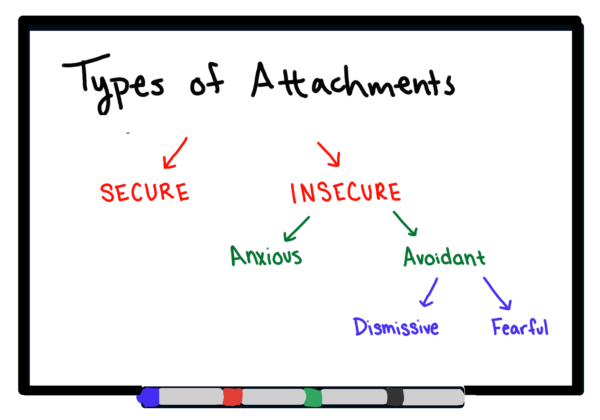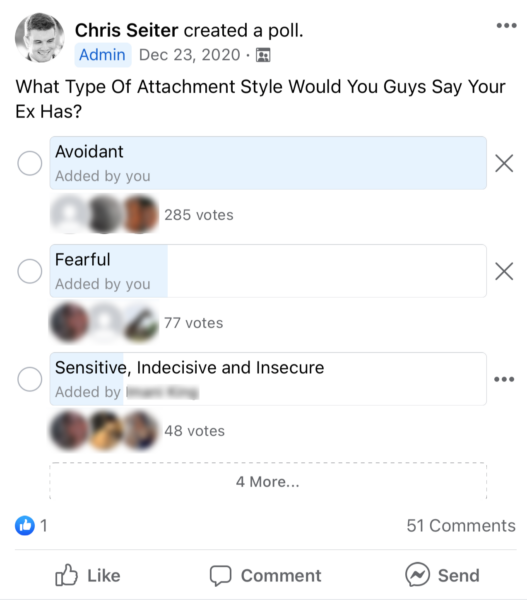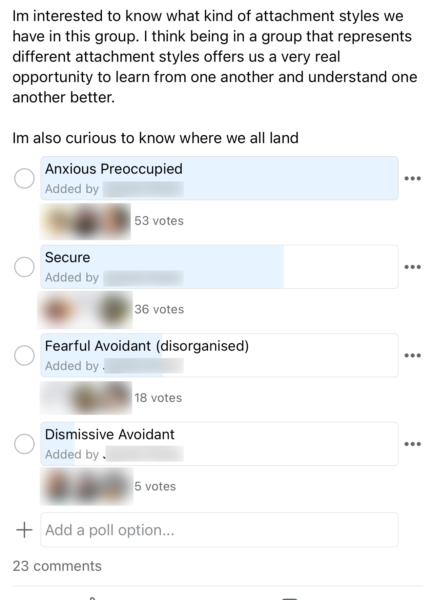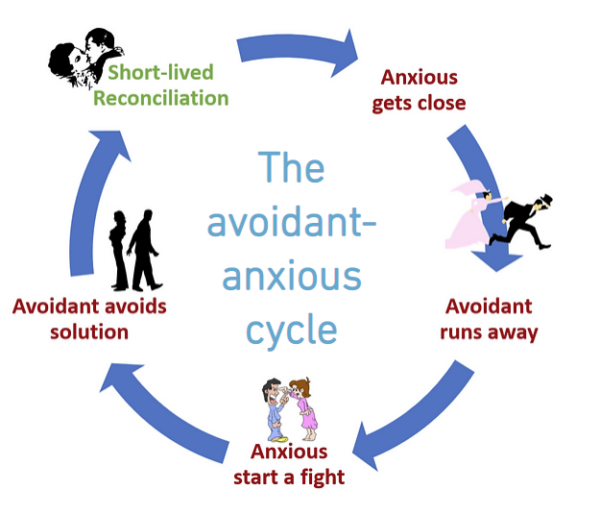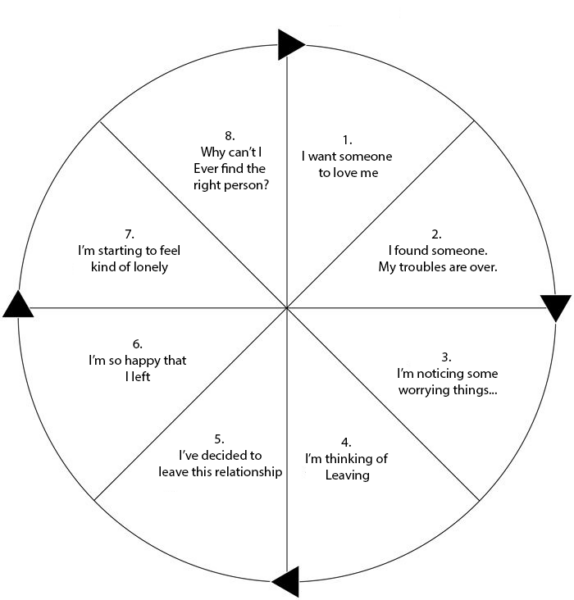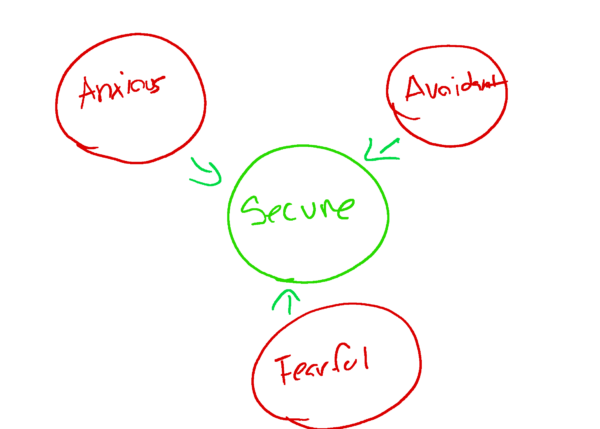Today we’re going to take a look at the most common attachment pairing we see in our coaching practice, the anxious/avoidant pairing.
And we’re going to do this by looking at the attaching pairing from the lens of three different categories,
- Helping You Understand What The Anxious And Avoidant Attachment Styles Are
- Helping You Learn Why The Avoidant Is Initially Attracted To The Anxious Attachment Style
- Taking A Look At The Anxious/Avoidant Self Fulfilling Cycle
There’s a lot to cover here so let’s begin.
Defining The Anxious And Avoidant Attachment Styles
Attachment theory is a set of ideas about how we love and how our childhood affects it created by John Bowlby in the 50’s and 60’s.
He argued that there are really two types of attachment styles,
- Secure ones
- Insecure ones
Of course, there are three distinct insecure attachment styles,
- Anxious
- Avoidant
- Fearful
I know it’s a bit complicated but bear with me here. Without a doubt the most common pairing we see in our coaching practice is between people with avoidant attachment styles and anxious attachment styles.
We think this is because predominately our audience exhibit them.
For example, a poll done in 2020 found that most of our clients exes were avoidant by nature,
And a poll done just this year found that most of our clients tend to be on the anxious side of things,
So, what are the traits of these attachment styles? Well, one of my colleagues, Tyler Ramsey, did an interview with me a few months ago where he brought up a really interesting point,
He essentially argued that every insecure attachment contains its own “core wound” that can explain their behavior.
More on that in a second, let’s first start by defining the characteristics of the anxious and avoidant attachment styles.
- Anxious Attachment Style: Will think highly of others but have low self esteem. Put themselves fully into relationships and grow increasingly desperate to hold on to the relationships. Their whole identity is wrapped around the relationship making them more prone to desperate types of behaviors
- The Avoidant Attachment Style: Someone who fiercely values their independence. So much so, that when someone threatens it they retreat. At an early age they were often neglected and had to learn how to self soothe. As a result, they tend to be lone wolves more often than not.
But what are the core wounds of the avoidant and anxious attachment styles?
Easy,
- Anxious Core Wound: Fear of Abandonment
- Avoidant Core Wound: Fear of Losing Their Independence
These core wounds effectively serve as triggering points for both the anxious and avoidant attachment styles and as you can imagine they often get triggered when they enter into relationships with one another.
Which leads us to an interesting question.

What Are Your Chances of Getting Your Ex Boyfriend Back?
Take the quizWhy Is The Avoidant Is Initially Attracted To An Anxious Attachment Style?
For months I puzzled over this question. On the outside it can feel like the anxious attachment style is prime to trigger the avoidants core wound and so they’d immediately flee but that’s not actually what occurs.
So what gives?
Well, the first thing we need to do is really try to understand the paradox that lies within the avoidant,
They want to fall in love but they won’t let anyone close enough to let this truly happen.
And then I found this paragraph from expert attachment website, Free to Attach,
Unconsciously they do not expect to be left as they understand attachment figures as omnipresent and engulfing, so they seek out partners who are unlikely to leave through avoidant behaviours.
Weirdly an avoidant is searching for someone that they can exert some type of control over, someone that they know is unlikely to leave.
Often you’ll find an avoidant threaten to leave the anxious person in the relationship as a way of exerting control and keeping them at a distance.
Which leads us to the other side of the equation.
Why Are Anxious Individuals So Attracted To Avoidant Individuals?
Everything starts with the core wound and so that’s where we’ll start. For an anxious individual the core wound is simple, they are afraid of being left.
So, this tells us that anxious individuals are often desperate to have a relationship in general. So, when they encounter an avoidant and the avoidant suddenly pulls away it often triggers them causing them to want to invest more into the relationship.
It’s the push/pull principle except backwards.
Pretty soon once the relationship starts the self fulfilling cycle begins.
The Self Fulfilling Avoidant Cycle
Have you ever wondered why we’ve seen so many on again/off again relationships between this pairing. In fact, Free to Attach, has their very own graphic depicting the vicious cycle between this pairing,
Well, believe it or not I’ve created my own graphic basically detailing the struggles these two attachment styles have when partnered with one another.
One that I personally feel is a little more detailed than what is pictured above,
There are eight distinct stages,
- The avoidant starts by thinking “I want someone to love me”
- Next when they’ve found that person they think, “This is great my love troubles are over.”
- Then the avoidant person starts to notice some anxious behaviors from the other person and the cracks begin to form
- Once this goes on long enough the avoidant person starts debating on when they’re going to leave
- Then they actually leave
- Then they feel super happy about the fact that they left. But if enough time goes by where they’re left alone they start to feel a bit lonely
- Which leads them to start thinking that they can’t ever find the right person for them
- Then they start thinking “I want someone to love me.”
Now, take special note of the fact that every time any kind of retreating behavior occurs in this cycle it’s usually because of the natural friction occurring between the anxious and avoidant attachment styles.
Ironically though, it’s the avoidant who seemingly will feel like Sisyphus eternally pushing the boulder up the hill. Always craving a deeper commitment but never allowing themselves permission to let anyone close enough so they can feel that deeper commitment.
Pulling again from Free to Attach,
Researchers found that avoidant individuals actually prefer anxiously attached people above all others, and vice versa. Each reaffirms the other’s beliefs about themselves and about relationships. The avoidants’ defensive self-perception that they are strong and independent is confirmed, as is the belief that others want to pull them into more closeness than they are comfortable with.
So, here’s what I want you to do. Any time you think of an avoidant simply equate them to this tragic self fulfilling cycle.
Is There Any Way To Break This Vicious Cycle?
I think this may be the most difficult part of the article for people to read because “the solution” isn’t really simple and it takes more time than most people are willing to invest.
If you think about it both the anxious and avoidant attachment tendencies have been engrained into a persons chemistry from childhood.

What Are Your Chances of Getting Your Ex Boyfriend Back?
Take the quizReading an article one time isn’t usually going to be enough to “solve” it. However, by simply seeking a knowledge and understanding of how this all works you are on the right path.
There is such a thing as “secure attachment gravity.”
Remember when I started this article I mentioned there are really only two types of attachment styles?
- Secure Ones
- Insecure Ones
Well, the goal for every insecure attachment style should be to shift their attachment towards being secure. Only then will you find relationships as a whole can become healthier and more productive.
Of course, it’s easier said than done and just because one person becomes more secure doesn’t mean the other person will. However, researchers have noticed an interesting phenomenon occur.
For arguments sake let’s pretend that you have an anxious attachment style and after being exposed to more secure individuals and a lot of “shadow work” you come out the other end and feel more secure yourself.
As you are around your ex, since you are more secure, you aren’t triggering them as much. A type of gravity occurs,
One in which the avoidant, seeing you be more secure, can slowly start to become more secure themselves. This is because we learn our attachment styles through human connection and comradery.
Of course, this is the glass half full view of things.
What usually happens is that the secure person, recognizing the avoidant person having severe flaws, won’t stick around long enough for the gravity to take shape.
From my perspective though this is still kind of a glass half full view. You see, anxious individuals often stick with unhealthy relationships for far too long. Leaving them in toxic situations and trapping them in their own self fulfilling cycle they can’t escape.
So, as is so often the case when it comes to attachment styles everything usually comes back around to becoming more secure and creating those healthy patterns.
It’s never too late to begin.
